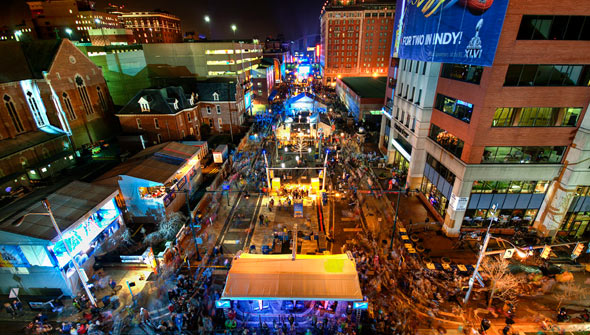Georgia Street
From Capitol venue to Pennsylvania Street, Downtown

Already the successful host of the Super Bowl Village in 2012, Georgia Street is quickly becoming the next great public space in Indianapolis.
One of the original streets on Alexander Ralston’s plat for the City, Georgia Street, in the Fall of 2011 reopened as a three-block long outdoor event venue bookended by the Indiana Convention Center and Banker’s Life Fieldhouse. A centerpiece of the Downtown entertainment destination, the historic Wholesale District, Georgia Street has been transformed into a curb-less, shared space - a pedestrian-first corridor, similar to Indianapolis’ iconic Monument Circle. The urban designers of the street, RATIO Architects, looked to create a compelling venue for impromptu, intimate gatherings and an enhancement to the full array of the City’s entertainment, shopping and culinary offerings.
Where once there were 6 lanes dedicated to automobiles, there is now new public space with trees, specialty lighting, sidewalk and boardwalk cafes, adjustable solar shades, retail kiosks and historic markers.
Public art aimed at showcasing Hoosier history was installed to further enhance the outdoor space. Ten finely crafted “Hoosier Pillars” commemorating historically significant leaders dot the streetscape. Each marker is seven feet tall, with a biography and a likeness drawn by Indianapolis artist James Kelly. Civic leaders hope to install as many as 30 of these historical markers along the street.
Additionally, a series of large sculptures are planned to be installed over time. The first of which was installed in March 2012, a bronze sculpture, designed by Jeffrey Rouse, the sculpture recognizes the life of Purdue University All-American and UCLA coaching legend John Wooden.
But - Georgia Street is not just another pretty space, its hard working too. In addition to serving as a compelling everyday destination for enjoying intimate outdoor dining and leisure opportunities, Georgia Street is designed with the flexibility to serve small to very large community celebrations, festivals, art shows, concerts and conventions. The specially designed catenary system, supported by regularly spaced columns running the length of the street, holds the primary source of light for the median, adding ambiance to the outdoor space. At the same time, it provides the opportunity for event-specific lighting and theming and distributes data and power supplies throughout the corridor.
Georgia Street is also a model of urban sustainability – necessary infrastructure that is simultaneously green and beautiful. Reversing the traditional curb and gutter approach, the street slopes to the middle, allowing rainwater to flow through the wide boardwalk that traverses the central pedestrian space. Made of sustainably harvested hardwood, the boardwalk covers a rainwater infiltration chamber that allows stormwater to percolate into the ground, recharging our aquifer and reducing the load on the City’s combined sewers. Canopy trees and associated plantings reduce the urban heat island effect, sequester CO2, mitigate hot Indiana summers and insert a living ecology into the urban environment. Other sustainable measures on Georgia Street include native plant communities, energy efficient lighting, recycled and locally sourced hardscape materials and captured rainwater used for plant irrigation.
Georgia Street has already been on the national stage, hosting more than a million people during the 9 day celebration surrounding Super Bowl 46. Locally it has become a household name and is well on the way to becoming another great place to visit in downtown Indianapolis.
